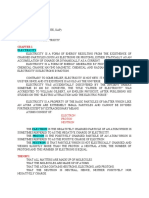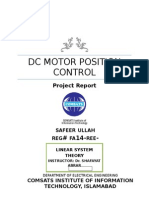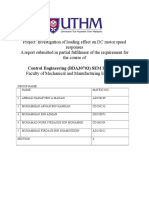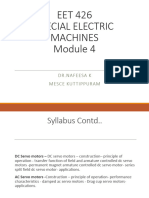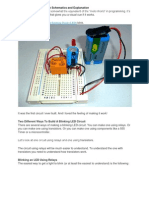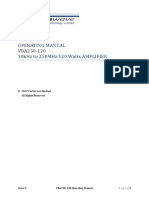Control Lab Manual 01
Uploaded by
doppler9effectControl Lab Manual 01
Uploaded by
doppler9effect.
lld
Yxetc$e l:
Open n-oop Servo Motor Static Characteristics
ExERcISE OBJEcTIVE When you have completed this exercise, you will be familiar with the various
mechanical and electrical components of a brush-type permanentmagnet dc
servo motor system. You will know how to analfze the steady state behavior of
the dc servo motor in open loop mode. You will be able to calculate and develop
the relationship between the dc voltage applied to the seryo motor and the motor
speed.
DrscussroN ourLtNE The Discussion of this exercise covers the following points:
o lntroduction to the functioning ofthe Digital Servo
u Components and variables ofa servo motor
, Open loop control vs. closed loop control
. Steady state analysis of a dc servo motor
" Calculating the motor steady state speed constant
DtscusstoN lntroduction to the functioning of the Digital Servo
The Digital Servo system uses a brush-lype permanent-magnet dc motor. As
with conventional dc motors that employ a field winding, permanent-magnet dc
motors create mechanical energy by the interaction between the magnetic field
created by current flowing through the armature windings and the magnetic field
created by the permanent magnet (typically made from ceramic or rare-
earth/cobalt alloys).
The interaction between these two magnetic fields produces a force (called the
torque) that causes the rotor/armature to rotate. The connections to the
armature windings are made through brushes, which commutate or switch the
current to the armature winding loops in order to produce a torque that causes
the rotor/armature assembly to rotate continuously. Reversing the polarity of the
dc power supply to the armature results in a cunent flow to the armature
windings that produces a torque causing the rotor/aimature to rotate in the
opposite direction.
The use of a permanent magnet instead of field coils reduces the amount of
energy consumed by the motor, the heat load created by wound field coils, and
the frame size. Permanent-magnet dc motors also have a lower armature
inductance, which results in a quicker response to changes in the armature
current.
tdbllalr. Digital Servo Motor Control 2'l
Exercise 2 - Open Loop Servo Motor Static Characteristics 4 D,scusslon
Cornponents and variables of a seruo rnotor
For the purposes of analysis, a dc motor can be simplified into the model shown
below:
T,A
Figure 18. DC motor electromechanical model.
The following variables will be used in this manual to identify the various forces
interacting in a dc motor:
. The supply voltage E (V)
. The motor current 1,4 (A)
. The armature winding inductance L (mH)
. The armature winding and brush resistance R (O)
. The counter-EMF voltage 7 (V)
. The motor output torque T (N.m)
. The motor speed ar (rad/s)
The counter or back EMF (Electro Motive Force) l/ is the voltage induced in the
armature due to the relative motion of the armature windings through the
magnetic field created by the permanent magnet. This voltage is proportional to
lhe motor speed (l-).
The motor input power is the product of the supply voltage E by the armature
current I4.
The motor output power is the product of the torque I and the motor speed (d.
22 Digital Servo Motor Control 4ry.
Exercise 2 - Open Loop Servo Motor Static Characteristics $ Discussron
It is important that you have
The following motor parameters are important for the study of a servo motor
a good understanding of system and are generally supplied by the motor manufacturer:
these motor parameters and
their relations with each . The inductance f (mH)
other before going further in
this manual. . The resistance R (Q)
The torque constant Kr (N m/A)
The voltage constant KE tv/(rad/s)l
The motor inertia,/, (kg m')
The following motor parameters are determined experimentally:
. The starting friction iorque Ty (N m)
. The dynarnic friction torque Id (N'm)
o The viscous friction coefficient I [N m/(rad/s)l
The torque f developed by the motor is the product of the torque constant l(r
and the armature current 11.
The counter EMF voltage y developed by the motor is the product of the voltage
constant KE by the motor speed (,r.
The dynamic friction torque 7d is determined by measuring the motor current
when no load is applied and multiplying this value by the torque constant Kr at a
given motor speed (,.
The viscous friction coefficient B is found by dividing the dynamic friction
torque Id by the motor speed (,.
The starting friction torque Il is determined by multiplying the minimum current
required to cause continuous rotation by the torque constant I(r.
Open loop control vs. closed loop control
In Exercise 2 and Exercise 3, we will concentrate on the Digital Servo operation
in open loop control, which means that ihe controller computes its input into the
system using only the system current state and its own model of the system
without taking into account any exterior feedback. Exercise 4 and Exercise 5 will
concentrate on the Digital Servo behavior in closed loop control, which means
that the controller uses environmental feedbacks to control the states or the
outputs of a dynamical system through various means (integral and derivative
action for example). These means are discussed in Exercise 9.
To befter understand the distinction between these two control systems, consider
a car cruise control system. ln an open loop control system, the cruise control
controller locks the vehicle speed at the desired gas entry value for a certain
speed. This, however, does not take into account any disturbance that might
affect the vehicle speed, e.9., downhill or uphill tenain, weather, vehicle load, etc.
lry!" Digital SeNo Motor Control
Exercise 2 - Open Loop Servo Motor Static Characteristics + Dlscusslon
The vehicle speed will thus fluctuate depending on the driving conditions. ln a
closed loop control system, on the other hand, the controller takes into account
such feedback in computing its output and tries through various means to
compensate for it, which greatly reduces lhe output error, i.e., the difference
between the desired speed and the actual speed.
Steady state analysis of a dc servo motor
To do the steady state analysis, we will ignore the motor inductance L and the
motor inertia/M. Using the basic equations for a dc motor operating in a steady
state, we can develop the steady state characteristics and find the following
equations:
E=leR*V (1)
where E is the supply voltage (V)
/,{ is the armature current (A)
R is the armature winding and brush resistance (O)
Y is the counter-EMF voltage (V)
V=Ktu (2t
where Y is the counter-EMF voltage (V)
KE is the motor voltage constant MGad/s)l
a is the motor speed (rad/s)
T = Krle (3)
where ? is the motor output torque (N.m)
Kr is the motor torque constant (N'm/A)
L is the motor cunent (A)
r=Ba (4)
where I is the motor output torque (N.m)
I is the motor viscous friction coefficient [N.m/(rad/s)]
o is the motor speed (rad/s)
Using Equation (1), Equaiion (2), Equation (3), and. Equation (4), the motor
steady state speed r,rrr, usually expressed in rad/s, can be shown to be equal to:
(s)
,* = RB+.K,E
where r..-r* is the motor steady state speed (rad/s)
ln Exercise 2 we will only deal with the motor's steady state characteristics.
Exercise 3 will deal with the transient behavior of the dc motor, i.e., its behavior
before it reaches its steady state.
24 Digital Se.vo Motor Control @W.
' Exercise 2 - Open Loop Servo Motor Static Characteristics a Procedure Outline
Calculating the motor steady state speed constant
From Equation (5), we can define the relationship between the motor steady
state speed ar and the dc voltage E applied to the motor as the steady state
speed constant Ks. The equation for Ks is shown below:
..
xt= Kr (6)
ns+Yuh
where Ks is the motor steady state speed constant [(rad/s)A{
The development of this equation is given in Appendix B.
The motor steady state speed constant I(s determines the steady state speed of
the dc servo motor. That is, the motor steady state speed (,ss is equal to the
product of I(s and the supply voltage or: I
o55 = K5E (7)
where r.-tss is the motor steady state speed (rad/s)
Example
Table2 shows various characteristics of a brush-type permanent-magnet dc
motor. Using these, it is possible to find the value of the motor steady state
speed constant Ks.
Table 2, Brush-type pe.manenl-magnet dc motor characteristics.
Parameter Unit Value
Torque constant Kr N m/A 0.105
Voltage constant KE V/(rad/s) 0.105
Resisiance R o 2.O3
Viscous friction
N m/(rad/s) 0.0000708
coefficient B
Substituting the values shown in Table 2 into Equation (6), we obtain a Kr value
of:
r' = ;;;;##;;r-.-" = 9 4 (radls)A/
PRoCEDURE OUTLTNE The Procedure is divided into the following sections:
' SetuP and connections
" Viscous friction coefficient
Steady state speed constant
hry!& Digital Sewo Motor Control 25
Exercise 2 - Open Loop Servo Motor Static Characteristics . Procedure
PRoGEDURE Setup and connections
ln this section, you will setup the Digital Servo for measuring the motor steady
state sPeed constant 1(s.
Table 3 shows the motor parameters of the Digital Servo.
Table 3. Motor parametors from ths manufacture/s data sheet.
Parameter Untt Valuo
Rated speed (.) rpm 3400
Registance R o 2.23
Torque constant I(r N m/A o.'t2'l
Voliage @nstant /(E V/(rad/s) 0.'t2'l
l. Make the following settings on the Digital Servo system:
. Setup the servo system for speed control, i.e., dis€ngage the
platform.
. Set the belt tension to allow the belt to be lifted of the pulley
connected to the motor shaft and slipped on the two pins to the rear
of the pulley, allowing the shafr to run uncoupled from the belt.
. Secure the flywheel to the shaft using the appropriate hex key.
26 Digital Seruo Motor Control @W"
Exercise 2 - Open Loop Servo Motor Static Characteristics , Procedure
2. Run LVServo, and click on the Device Controlled button in the Speed Loop
menu. Make sure the settings are initially as shown in Table 4:
Table 4. Settings for measuring the viscous frictign coefficient B,
Function Generator Trend Recorder
SignalType Constant Reference Unchecked
Speed Unchecked
Cunent Checked
Offset 100% Voltage Checked
Power oft Error Unchecked
PID Controller Kp x Error lJnchecked
Error Sum / ti Unchecked
t,r x Delta Error Unchecked
PID Output Unchecked
Display Type Seveep
Timebase 10 ms Show and Record Data On
Measured Gain (rpm) 3000
l\reasured Gain (A) 7
l\ileasured Gain (V) 48
Open or Closed Loop Open
PV Speed Scaling
100% Value 3000 rym
3. Set the function generator Power switch to ON.
4. When the motor attains its steady state (this should take about one second)
execute the procedure seen in the previous exercise to capture a few
seconds of operation, then stop the recorder and export the data to a spread
sheet.
5. Set the function generator Power switch to OFF, to turn off the motor.
Viscous friction coefficient
ln the next steps, you will determine lhe viscous friction coefficient I by
multiplying the armature cunent /,{ by lhe torque constant K? at a supply voltage
of 48 V dc, and then dividing the dynamic friction torque Id by the motor
speed o (radls).
ryt" Digital Setvo Motor Control 27
Exercise 2 -- Open Loop Servo Motor Static Characteristics Procedure
"
6. Using the exported data, determine the armature current 1,4 (A) by taking the
current reading in percentage and multiplying it by the measured current gain
value. This value should be of 7 A if the default value has not been changed.
Ie=
7. Determine the dynamic friction torque Td by multiplying the armature curent
/3 by the torque constant Kr (use the Kr given in Table 3, i.e., 0.121 N m/A).
The resulting equation is:
T6 = K7l1 (8)
where Id is the dynamic friction torque (N m)
Ta= Nm
Determine the motor speed (l) (rad/s) using Equation (9). To find the motor
speed in rpm oRpM, multiply the speed value in percentage by the measured
speed gain. This value should be of 3000 rpm if the default value has not
been changed:
Ztt (e)
60
where rrrapy is the motor speed in rpm
@ = rad/s
Determine the viscous friction coefficient I
by dividing the dynamic friction
torque ?d by the motor speed 0r, as shown in Equation (10):
(10)
B =T!
a
B= N m/(ad/s)
Steady state speed constant
ln this section, you will calculate the motor steady state speed constant Ks. You
will then determine I(s experimentally by plofting a motor speed versus voltage
curve fiom the data obtained by running the servo motor. The resulting plot slope
corresponds to the measured steady state speed constant.
28 Digital Seruo Motor Control ry,
Exercise 2 - Open Loop Servo Motor Static Characteristics s Procedure
10. Calculate the theoretical value of the steady state speed constant Ks using
Equation (6). You will need to use your calculated viscous friction
coefficient B along with lhe KE, Kr, and R values supplied by the motor
manufaciurer (see Table 2). The theoretical value of Ks is thus:
Ks =_(rad/s) /
'!1. Run LVServo, and click on the Device Controlled button in the Speed Loop
menu. Make sure the settings are initially as shown in Table 5:
Table s.Settings for measuring the motor Kr value.
Function Gsnerator Trend Recorder
SignalType Triangle Reference Checked
Frequency 0.01 Hz Speed Checked
Amplitude 100% Currenl Unchecked
Offset 0% Voltage Checked
Power oft Error Unchecked
PID Controller Kp xEfiot lJnchecked
Enor Sum / t, Unchecked
td x Delta Error Unchecked
PID Output Unchecked
Display Type Sweep
Timebase 999 ms Show and Record Data On
Measured Gain (rpm) 3000
Measured Gain (A) 7
Measured Gain (V) 48
Open or Closed Loop Open
PV Speod Scaling
100% Value 3000 rpm
12. Set the time base to a very slow time of 999 ms. This will allow the motor to
reach its steady state speed during each sample. You will thus acquire a
series of motor speeds generated by a very low frequency triangle wave over
a range from minimum voltage to maximum voltage.
13. Set the function genelator Power switch to ON.
14. Capture a complete period (starting with the minimum value) and export it to
a spreadsheet.
The speed provided in the expofted data is in percentage of 3000 rpm. To
conveft to rad/s, multiply the speed in rpm (%) by n. Note also that the voltage
in the expofted data is a percentage of 48 V dc.
ry, Digital seruo Motor control 29
Exercise 2 - Open Loop Servo Motor Stalic Characteristics , Procedure
'15. Use a spread sheet or similar mathematical tool to plot the motor steady
state speed (,)ss in radls versus supply voltage g. Your plot should look
similar to the one shown in Figure 19.
Figure 19. Steady state motor 3peed (.r$ vs supPly voltage E example.
fn fn" flat portion of the curve is due to the static friction that the motor torque
^Y/ must overcome before lhe motor begins to rotate. This motor rotation occurs at
the voftage that provides the required cunent and consequently the motor
torque necessary to overcome the static friction. lf the motor was ideal and
static fiction 0, the relationship between the steady state speed @ss and the
supply voftage E would simply be: i,ss = KsE.
16. Using your plot, calculate the slope and develop the equation that relates
steady state motor speed a)ss vs dc supply voltage E for the servo molor.
Use the slope X intercept form of the straight line equation:
Y=m(X-Xr)
Slope m = (radis)^r'
X1 intercept =
(dss =
30 Digital Servo Motor Control leL?W
. Exercise 2 - Open Loop Servo Motor Static Characteristics + Conclusion
17. Complete Table 6 below by entering the calculated and measured values of
(s:
Table 6. Calculated and measured motor steady state constant ,(s values.
Parameter Calculated. Measured
Ks
[(radls)M
CoNCLUSTON ln this exercise, you were introduced to the various components that make up a
brush-type permanent-magnet servo motor. You analfzed the steady state
characteristics of the servo motor system operating under open loop control.
From experimental measurements, you were able to determine the steady state
speed constant I(s of a servo motor and compare it with the value calculated
using the manufacturer's data.
REvtEw QuEsTtoNs 1. How is the steady state speed (,ss affected by a decrease in dc supply
voltage E?
2. lf the motor is loaded in such a way that the viscous friction coefficient B
increases, how is the steady state speed r,r55 affected?
3. ln the steady state speed vs. supply voltage plot (Figure 19), explaln why
there is a "flat'or horizontal reqion in the middle of the curve.
4. Explain the difference between open loop and closed loop control systems.
tdb.l/oa, Digital Seruo Motor Control 31
You might also like
- Experiment No 12 A-Motor Speed and Input Characteristics: Objective100% (1)Experiment No 12 A-Motor Speed and Input Characteristics: Objective8 pages
- Building Utilities 2: Casulla, Cristine T. Bs in Architecture 3 University of LuzonNo ratings yetBuilding Utilities 2: Casulla, Cristine T. Bs in Architecture 3 University of Luzon20 pages
- Servomotors: by Joseph M Abraham Aeronautical DeptNo ratings yetServomotors: by Joseph M Abraham Aeronautical Dept17 pages
- Determination of the Transfer Function of a Servo Motor[1]No ratings yetDetermination of the Transfer Function of a Servo Motor[1]17 pages
- Experiment - 4 Characterization of DC Motor: Part 2No ratings yetExperiment - 4 Characterization of DC Motor: Part 213 pages
- Mathematical Modeling of Open Loop PMDC Motor Using Matlab/SimulinkNo ratings yetMathematical Modeling of Open Loop PMDC Motor Using Matlab/Simulink6 pages
- Review of Electric Motor Drives: September 2015No ratings yetReview of Electric Motor Drives: September 201529 pages
- Experiment No: 1: Aim: Apparatus RequiredNo ratings yetExperiment No: 1: Aim: Apparatus Required29 pages
- Control Systems ME-314: Electromechanical System Transfer FunctionsNo ratings yetControl Systems ME-314: Electromechanical System Transfer Functions21 pages
- Servo Loop Control Steady: Closed Speed Characteristics100% (1)Servo Loop Control Steady: Closed Speed Characteristics7 pages
- 2.8 Electromechanical System Transfer Functions: Skill-Assessment Exercise 2.10No ratings yet2.8 Electromechanical System Transfer Functions: Skill-Assessment Exercise 2.106 pages
- Handbook and Application Guide For High-Performance Brushless Servo SystemsNo ratings yetHandbook and Application Guide For High-Performance Brushless Servo Systems26 pages
- EE 111 Final Project: Permanent Magnet DC MotorNo ratings yetEE 111 Final Project: Permanent Magnet DC Motor3 pages
- Working Principles Need of Dynamic Modeling and Accurate Control of Motor Drives Dynamic Modeling of DC Machine Control of DC MachineNo ratings yetWorking Principles Need of Dynamic Modeling and Accurate Control of Motor Drives Dynamic Modeling of DC Machine Control of DC Machine23 pages
- Control Tutorials For MATLAB and Simulink - Motor PositionNo ratings yetControl Tutorials For MATLAB and Simulink - Motor Position6 pages
- Lecture Actuators For Mechatronics Applications Updated On March 22No ratings yetLecture Actuators For Mechatronics Applications Updated On March 22164 pages
- Advanced Electric Drives: Analysis, Control, and Modeling Using MATLAB / SimulinkFrom EverandAdvanced Electric Drives: Analysis, Control, and Modeling Using MATLAB / SimulinkNo ratings yet
- L6386D - High-Voltage High and Low Side DriverNo ratings yetL6386D - High-Voltage High and Low Side Driver11 pages
- Temperature Thermistor Resistance Theorical ADC Value °C °F Kelvin Ω Input (V) Output (12bits)No ratings yetTemperature Thermistor Resistance Theorical ADC Value °C °F Kelvin Ω Input (V) Output (12bits)2 pages
- Lab-Volt 8063 Digital Servo System - Getting Started PDFNo ratings yetLab-Volt 8063 Digital Servo System - Getting Started PDF7 pages
- Quick Assembly Two and Three Channel Optical Encoders: Technical DataNo ratings yetQuick Assembly Two and Three Channel Optical Encoders: Technical Data15 pages
- Bearing Style, 3-Channel Encoder: μoiss (.00015 oz-in-sec2)No ratings yetBearing Style, 3-Channel Encoder: μoiss (.00015 oz-in-sec2)1 page
- MOTOR ID23005 128W: Ratings Symbol UnitsNo ratings yetMOTOR ID23005 128W: Ratings Symbol Units2 pages
- Pneumatics: Training Systems SERIES 6081No ratings yetPneumatics: Training Systems SERIES 608132 pages
- PLC (Programmable Logic Controller) : Sequencers Can Be Replaced by PLCNo ratings yetPLC (Programmable Logic Controller) : Sequencers Can Be Replaced by PLC10 pages
- D E & C E EEE 321, ETE 321 Introduction To Communication Systems LabNo ratings yetD E & C E EEE 321, ETE 321 Introduction To Communication Systems Lab1 page
- North South University Academic Calendar Summer 2019: Holiday-Buddha PurnimaNo ratings yetNorth South University Academic Calendar Summer 2019: Holiday-Buddha Purnima1 page
- An Active Two-Stage Class-J Power Amplifier Design For Smart Grid's 5G Wireless NetworksNo ratings yetAn Active Two-Stage Class-J Power Amplifier Design For Smart Grid's 5G Wireless Networks18 pages
- Medium Frequency Induction Melting Furnace: VantageNo ratings yetMedium Frequency Induction Melting Furnace: Vantage6 pages
- Simmons EWC18e Chapter08 Review-QuestionsNo ratings yetSimmons EWC18e Chapter08 Review-Questions4 pages
- Laboratory Experiment 2 (Magnetic Field)No ratings yetLaboratory Experiment 2 (Magnetic Field)7 pages
- Service Documentation: Market Release 12/95No ratings yetService Documentation: Market Release 12/959 pages
- VAC Choke Multivariadores sandCoresDatasheetNo ratings yetVAC Choke Multivariadores sandCoresDatasheet16 pages
- Excited States and Photochemistry of Organic Molecules - Martin KlessingerNo ratings yetExcited States and Photochemistry of Organic Molecules - Martin Klessinger281 pages
- Blinking LED Circuit With Schematics and ExplanationNo ratings yetBlinking LED Circuit With Schematics and Explanation3 pages
- Electrical Engineering: KCT College of Engg and Tech. Village Fatehgarh Distt - SangrurNo ratings yetElectrical Engineering: KCT College of Engg and Tech. Village Fatehgarh Distt - Sangrur23 pages
- Experiment No 12 A-Motor Speed and Input Characteristics: ObjectiveExperiment No 12 A-Motor Speed and Input Characteristics: Objective
- Building Utilities 2: Casulla, Cristine T. Bs in Architecture 3 University of LuzonBuilding Utilities 2: Casulla, Cristine T. Bs in Architecture 3 University of Luzon
- Servomotors: by Joseph M Abraham Aeronautical DeptServomotors: by Joseph M Abraham Aeronautical Dept
- Determination of the Transfer Function of a Servo Motor[1]Determination of the Transfer Function of a Servo Motor[1]
- Experiment - 4 Characterization of DC Motor: Part 2Experiment - 4 Characterization of DC Motor: Part 2
- Mathematical Modeling of Open Loop PMDC Motor Using Matlab/SimulinkMathematical Modeling of Open Loop PMDC Motor Using Matlab/Simulink
- Control Systems ME-314: Electromechanical System Transfer FunctionsControl Systems ME-314: Electromechanical System Transfer Functions
- Servo Loop Control Steady: Closed Speed CharacteristicsServo Loop Control Steady: Closed Speed Characteristics
- 2.8 Electromechanical System Transfer Functions: Skill-Assessment Exercise 2.102.8 Electromechanical System Transfer Functions: Skill-Assessment Exercise 2.10
- Handbook and Application Guide For High-Performance Brushless Servo SystemsHandbook and Application Guide For High-Performance Brushless Servo Systems
- Working Principles Need of Dynamic Modeling and Accurate Control of Motor Drives Dynamic Modeling of DC Machine Control of DC MachineWorking Principles Need of Dynamic Modeling and Accurate Control of Motor Drives Dynamic Modeling of DC Machine Control of DC Machine
- Control Tutorials For MATLAB and Simulink - Motor PositionControl Tutorials For MATLAB and Simulink - Motor Position
- Lecture Actuators For Mechatronics Applications Updated On March 22Lecture Actuators For Mechatronics Applications Updated On March 22
- Analog Dialogue, Volume 48, Number 1: Analog Dialogue, #13From EverandAnalog Dialogue, Volume 48, Number 1: Analog Dialogue, #13
- Advanced Electric Drives: Analysis, Control, and Modeling Using MATLAB / SimulinkFrom EverandAdvanced Electric Drives: Analysis, Control, and Modeling Using MATLAB / Simulink
- Temperature Thermistor Resistance Theorical ADC Value °C °F Kelvin Ω Input (V) Output (12bits)Temperature Thermistor Resistance Theorical ADC Value °C °F Kelvin Ω Input (V) Output (12bits)
- Lab-Volt 8063 Digital Servo System - Getting Started PDFLab-Volt 8063 Digital Servo System - Getting Started PDF
- Quick Assembly Two and Three Channel Optical Encoders: Technical DataQuick Assembly Two and Three Channel Optical Encoders: Technical Data
- Bearing Style, 3-Channel Encoder: μoiss (.00015 oz-in-sec2)Bearing Style, 3-Channel Encoder: μoiss (.00015 oz-in-sec2)
- PLC (Programmable Logic Controller) : Sequencers Can Be Replaced by PLCPLC (Programmable Logic Controller) : Sequencers Can Be Replaced by PLC
- D E & C E EEE 321, ETE 321 Introduction To Communication Systems LabD E & C E EEE 321, ETE 321 Introduction To Communication Systems Lab
- North South University Academic Calendar Summer 2019: Holiday-Buddha PurnimaNorth South University Academic Calendar Summer 2019: Holiday-Buddha Purnima
- An Active Two-Stage Class-J Power Amplifier Design For Smart Grid's 5G Wireless NetworksAn Active Two-Stage Class-J Power Amplifier Design For Smart Grid's 5G Wireless Networks
- Medium Frequency Induction Melting Furnace: VantageMedium Frequency Induction Melting Furnace: Vantage
- Excited States and Photochemistry of Organic Molecules - Martin KlessingerExcited States and Photochemistry of Organic Molecules - Martin Klessinger
- Blinking LED Circuit With Schematics and ExplanationBlinking LED Circuit With Schematics and Explanation
- Electrical Engineering: KCT College of Engg and Tech. Village Fatehgarh Distt - SangrurElectrical Engineering: KCT College of Engg and Tech. Village Fatehgarh Distt - Sangrur




